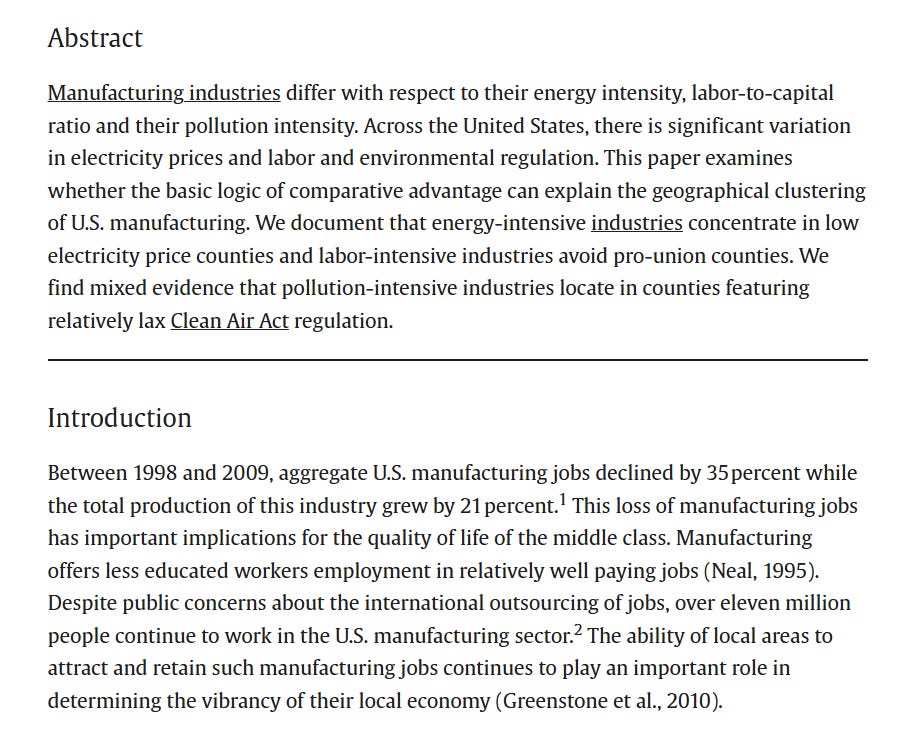NPR has posted a provocative piece arguing that most economists are naive about the distributional consequences of free trade between the United States and developing countries such as China. The piece hints that neo-classical economists allow our free market ideology to blind us from seeing “reality”.
The article presents an interview with David Autor about his important ongoing research on the consequences for the U.S economy and U.S workers as China’s exports to the U.S boomed after 2001.
In this Substack, I want to focus on these two quotes from the NPR piece.
Here is the 2nd quote;
My Thoughts
Consider the people who were most directly affected by the rise of China’s exports to the United States. These are U.S domestic manufacturing workers employed in industries in direct head to head competition with China’s manufacturing firms. These workers tend to be men living in Rust Belt cities who have a high school degree and were between the ages 30 and 50 in 2005. So, these individuals were born between 1955 and 1975.
Point #1 Most of these men attended public schools. The key “what if” here pertains to whether these men who lost their jobs in manufacturing would have had an easier time adapting to the China Shock if they attended schools that better prepared them for the modern volatile economy. What role did the public sector’s monopoly on providing K-12 education in these communities play in limiting the displaced workers’ ability to adapt when the local deindustrialization began? Under Milton Friedman’s “Rules of the Game”, these men would have had access to more school choice when they were young. The logic of human capital theory predicts that if one has received a better early education that this provides the necessary skills to be able to pivot in later life when circumstances change.
Point #2 Federal Government subsidies for home ownership encouraged many of these men to buy homes in the area where they worked. This incentive meant the workers in Rust Belt cities held an undiversified portfolio. When the negative demand shock for their industry occurred, these specialized towns experienced a rise in unemployment and a decline in local home prices. The workers who owned the local homes thus received a “double punch” from the shock caused by the Chinese exports. Urban economists have also noted that home ownership reduces spatial migration rates, which means home ownership can cause unemployment if homeowners are anchored to a declining area. The key “what if” here asks, “If U.S Rust Belt manufacturing workers had been renters, would they have been more likely to move away and to move to more vibrant local economies?” This dynamic would have accelerated their recovery from being displaced at their Rust Belt factory.
Point #3 State occupational licensing rules limited the ability of the displaced factory workers to pivot and move into another occupation.
Point #4 There is an open question concerning the role of cheap electricity, lax labor regulations, and lax environmental regulations in China in accelerating the Rust Belt's deindustrialization. In my co-authored 2013 paper, we explore what role has U.S regulations played in determining the geographic concentration of manufacturing within the U.S
I want to sketch out the Silver Lining of the Rust Belt deindustrialization. In my Green Cities work, I have argued that the impact of quality of life on cities such as Pittsburgh has been tremendous as the air and water quality has sharply improved. The benefits of such non-market quality-of-life factors should not be overlooked. Yes, the educated who do not work in manufacturing have gained the most from these amenity upgrades, but the overall gains are significant.
David Autor and his co-authors have generated some fascinating facts concerning U.S. Rust Belt trends over the last 25 years. These trends took place given the rules of the game that the State and Federal governments introduced. These rules slowed down our adaptation and injured the economic prospects of many middle-aged men who were directly exposed to the shock.
Federal, State, and Local regulations amplified the costs of the China Export Shock. If the U.S. had offered a better K-12 education using market competition and didn’t encourage spatial lock-in through housing subsidies, then the displaced workers would have had an easier time adapting to the shock!









Regarding point 1, I think the issue is the permanent loss to seniority and tenure. Even if one could retrain, the acquired job specific human capital is significant and lost. Moreover, I believe it was shown that a lot of former manufacturing workers moved into construction during the boom at that time (till 2008). Only once the great recession hit, the 'shock' fully materialized.
The environmental benefits point is a good one (although probably not first order).
I like your point about job seniority causing higher wages but I wonder whether this is due to union rules or true productivity on the job. The union quasi rents were caused by labor market imperfections.